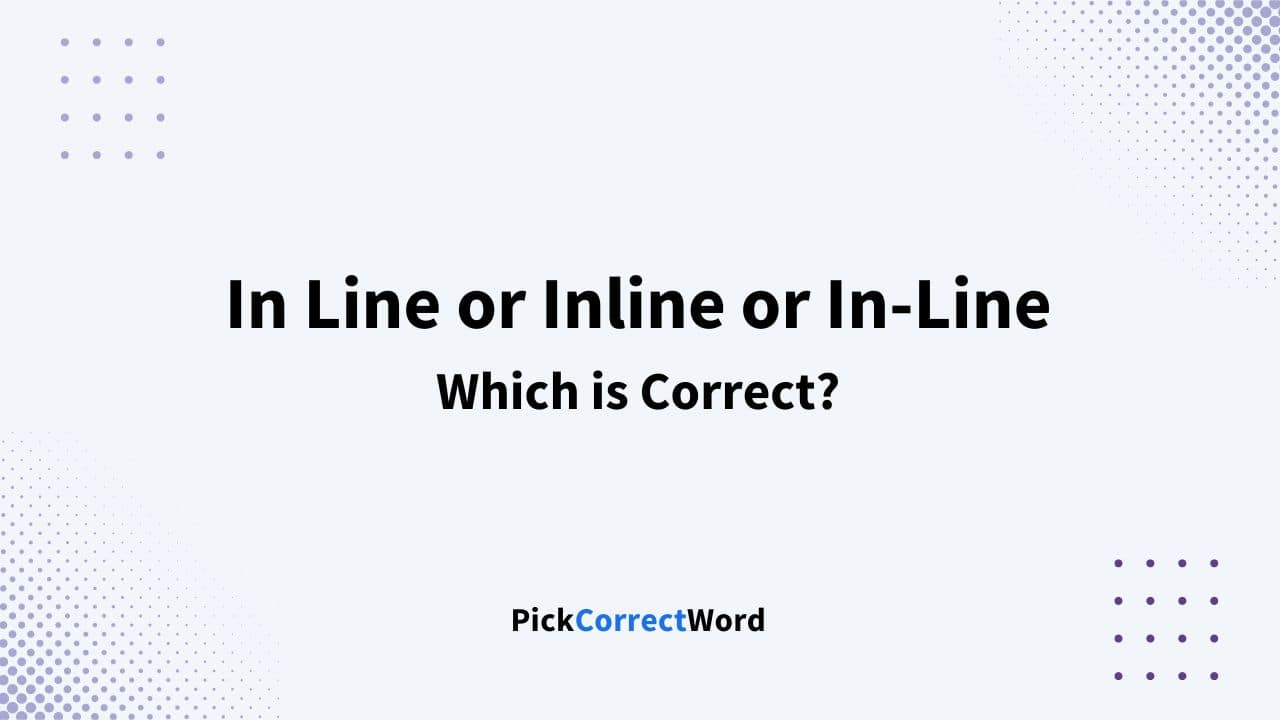When you see the terms ‘in line,’ ‘inline,’ and ‘in-line,’ you might think they all mean the same thing. But, that’s not the case.
While these phrases may seem like you can use them interchangeably, that’s not always true. Depending on the situation, one might be more suitable than the other.
Let’s dig into the subtle differences of these similar-looking terms and clear any doubts.
In Line or Inline or In-Line? Which is Correct?
The terms ‘in line,’ ‘inline,’ and ‘in-line’ are all correct, but they’re used in different situations.
‘In line’ usually talks about people or things set up in a straight line. It can also mean following a certain standard or expectation.
The term ‘in-line’ is often used to describe something that’s directly connected or fits well within a process or system. You usually use it as an adjective before a noun.
‘Inline’ is mainly used in technical and digital situations. This term is used when talking about inline functions in coding. It can also talk about elements on a webpage, like text or pictures, that are on the same line without any line breaks.
In line: Meaning and Usage
‘In line‘ means being in the correct order or sequence. When you say someone is ‘in line,’ it suggests they are following the right order or matching a particular standard. This can refer to both actual positioning, like standing one behind another, or metaphorical alignment, such as sticking to rules.
Role in grammar: ‘In line’ often works as an adverbial phrase, describing where an action happens or the state of something.
In some cases, ‘in line’ can also work as a prepositional phrase, connecting nouns to other words in the sentence.
For example, “Your interests are in line with ours.” The use of ‘in line’ in this situation suggests agreement or conformity.
Context of Use and Example
- Physical Queues: When you’re at a store, you might hear, “Please stand in line.” The request is for customers to queue up one behind the other.
- Conformity: If your behavior is consistent with the rules, someone might say, “You’re in line with our expectations.” This means that your actions are what they anticipate and accept.
In-line: Meaning and Usage
When you see ‘In-line‘ with a hyphen, it’s acting as an adjective. This means it’s describing a noun and should come right before it.
For example:
- In-line skates (where “in-line” describes the type of skates).
Context of Use and Example
Using ‘in-line’ correctly in your writing can help you express your ideas more accurately. For instance, in a sentence like “Make sure the filters are in-line with the pipes,” it tells you that the filters should be lined up in the same order as the pipes.
A common context of “in-line” is in technical and business settings. Consider:
- The in-line engine design improves efficiency.
- They maintained an in-line arrangement of products on the conveyer.
Inline: Meaning and Usage
‘Inline‘ is used as an adjective to talk about elements that are part of a line or sequence within a bigger structure.
Here’s a simple rule for you: if ‘inline’ is describing something, like ‘inline engine,’ then you don’t need spaces or hyphens.
The term ‘inline’ usually pops up in technical and specialized situations. In another scenario, like in sports such as skating, you’ll see phrases like ‘inline skates.’ This refers to skates where the wheels are set up in one straight line.
Examples of Using “In Line“ in A Sentence
“We need to stand in line to get tickets for the concert.”
“His thinking is in line with the company’s core values.”
“The students were asked to walk in line during the field trip.”
“Your project proposal is in line with our budget, so we can proceed.”
“The soldiers stood in line, waiting for their orders.”
“The books on the shelf are neatly arranged in line.“
Examples of Using “In-Line“ in A Sentence
“The in-line skates are designed for speed and agility.”
“Please ensure the documents are in-line with the company’s guidelines.”
“The in-line engine of the car provides better fuel efficiency.”
“Our manufacturing process uses an in-line assembly for faster production.”
“The in-line arrangement of trees in the orchard makes it easier to gather fruit.”
“The conveyor belt has an in-line scanner to check product quality.”
Examples of Using “Inline“ in A Sentence
“The HTML code for the website was written in an inline style.”
“She bought a new pair of inline skates to practice for the marathon.”
“The mechanic suggested getting an inline engine for better fuel efficiency.”
“In programming, using inline functions can help optimize the code.”
“The company introduced an inline inspection system to check product quality.”
“Inline styles in CSS allow you to apply unique styles to individual HTML elements.”
Frequently Asked Questions
What does ‘in line with’ imply in a business context?
In a business context, when you say something is ‘in line with’ it means that it conforms to a set of standards or expectations. Policies and practices that are ‘in line with’ company guidelines, for example, follow the principles established by the organization.
Which is the correct expression, ‘fall in line’ or ‘fall inline’?
The correct expression is ‘fall in line.’ This phrase indicates conformity or adherence to rules and regulations. It is often used when someone complies with the established guidance or authority.
What are the rules for using a hyphen in the phrase ‘on line’?
‘On line’ typically does not require a hyphen. However, when modifying nouns with a compound adjective before them, such as ‘on-line resources,’ a hyphen may be used to clarify that the resources are available online. This usage is less common, and ‘online’ as one word is often the preferred form.


